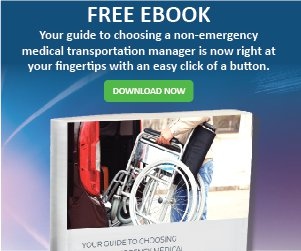 Regardless of the time of year, the threat of inclement weather can happen at any time. Winter storms with bone-chilling, frigid temperatures, and tornadoes, floods, thunderstorms, hurricanes or even earthquakes — are all real possibilities.
Regardless of the time of year, the threat of inclement weather can happen at any time. Winter storms with bone-chilling, frigid temperatures, and tornadoes, floods, thunderstorms, hurricanes or even earthquakes — are all real possibilities.
Such inclement weather can be a disruptive force in just about any aspect of everyday life, but non-emergency medical transportation is a particular concern for many.
Furthermore, inclement weather can wreak havoc on NEMT managers' IT infrastructure, impacting their fundamental operability. When disaster strikes, are you sure your NEMT manager will be able to continue service uninterrupted?
Inclement weather poses significant threat to NEMT services
Whether it’s heavy rainfall, hail, microbursts or buffeting hurricane-force winds, weather can impede NEMT services and leave members struggling to make travel arrangements, arrive at their appointments on time and even get back home safely.
Drivers may be unprepared - or unwilling - to drive on unclear roads riddled with toppled tree tops, broken branches, flooded intersections or even severed power lines, creating significant vehicle shortages. Downed power lines and phone lines can easily cause call, data or operating center outages, taking scheduling platforms offline as well as preventing members from making appointments over the phone.
Modern NEMT managers rely on data centers to host user-facing platforms like mobile apps and online scheduling portals to assist beneficiaries. However, those facilities are at risk for power and network outages when severe weather affects their area. A 2016 Ponemon Institute study revealed that weather-related incidents were among the top five causes of unplanned data center outages.
The most common culprit? Uninterrupted power supply failure. It just goes to show how important it is for your NEMT manager to have a contingency plan in place in case inclement weather brings down its primary operating center or causes any kind of network or service disruption.
Disaster recovery plans must be rigorously tested
Ask yourself: If your NEMT manager's call center lost power or network connectivity, would it be able to continue supporting your beneficiaries? Locally based non-emergency medical transportation brokers often rely on a single data or call center for all of their ride scheduling, driver assignment and support needs. In the event of an unforeseen weather event or disruptive incident, they may not have a reliable disaster recovery plan to maintain service while maintenance and repair work occurs.
It's true that the vast majority of companies have some kind of disaster recovery plan in place — 95%, according to Spiceworks— but not all of them actually audit and assess those contingencies to ensure they execute flawlessly. Approximately one-quarter of organizations never test their disaster recovery plans, and 14% only do so every few years. When disaster strikes, there's little room for error, and NEMT managers that cannot guarantee smooth service delivery while riding out the storm could be a liability.
Medicaid organizations and MCOs should not hold out hope that their NEMT broker will never experience such an outage, as recent research suggests data center downtime is more common than previously thought. A 2018 Uptime Institute study revealed that 31 percent of organizations had experienced some form of IT disruption in the past year. It's better to assume the worst and plan accordingly than face the consequences of unexpected operational failure.
Crafting a reliable disaster recovery plan
LogistiCare has thoroughly mapped out disaster recovery plans for all operating centers across the United States. Those contingencies have been tested repeatedly and often to prepare that systems failover as expected without resulting in service disruption. There are no surprises because every reasonably possible contingency has been anticipated and responses have been assessed and codified for efficient execution.
LogistiCare's nationwide footprint makes it that much easier for call center responsibilities to fail over to another facility that sits safely out of harm's way. If a winter storm, tornado or hurricane knocks out power at one of LogistiCare's sites, there are several operating centers that can pick up the slack in other parts of the country. With seamless failover capabilities, members may not even notice that their local call center is experiencing technical difficulties.
In extreme cases, where roads are difficult to navigate for even the most skilled drivers, LogistiCare can accommodate patients who absolutely must get to their appointments. Dialysis sessions, for instance, cannot be missed without putting a patient's health at great risk. LogistiCare has agreements in place with state and local emergency support services all throughout the U.S. to provide emergency transport in extremely urgent cases and has even helped evacuate members to locations where they can receive critical medical treatments.
Bad weather, power outages and network connectivity issues are no excuse for NEMT managers to suspend operations and leave patients in the lurch. LogistiCare's vast IT infrastructure has the comprehensive safeguards and contingency plans needed to provide reliable non-emergency medical transportation solutions even in the most difficult weather.



